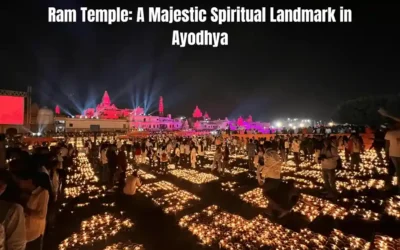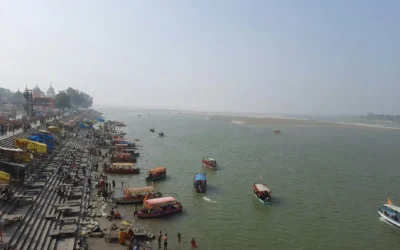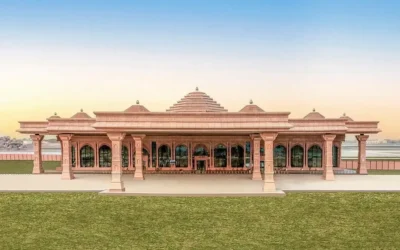Ayodhya, a city steeped in history and spiritual significance, is located in the northern state of Uttar Pradesh, India. Known as the birthplace of Lord Rama, Ayodhya attracts pilgrims and tourists from around the world. However, before planning a trip to Ayodhya, it’s crucial to understand the weather conditions, especially during the summer months, to ensure a comfortable and enjoyable visit. This article delves into the summer weather of Ayodhya, providing insights into whether this is an ideal time for travel.
Ayodhya’s Summer Climate: An Overview
Ayodhya experiences a humid subtropical climate, characterized by distinct seasons. Summer weather in Ayodhya typically spans from April to June, with temperatures soaring to uncomfortable levels. During this period, the city witnesses high temperatures, intense humidity, and occasional heatwaves.
- Temperature and Humidity:
- April: The onset of summer sees temperatures ranging between 25°C (77°F) to 38°C (100.4°F). The weather is generally hot, but bearable for those accustomed to warm climates.
- May: May is usually the hottest month, with temperatures often exceeding 40°C (104°F) during the day. Nighttime temperatures hover around 30°C (86°F), offering little relief from the daytime heat.
- June: As the month progresses, the mercury continues to rise, with daytime temperatures peaking at around 45°C (113°F). The high humidity levels, often exceeding 70%, make the heat feel more oppressive. By the end of June, the monsoon season begins to set in, bringing some respite from the heat.
- Rainfall:
- Although summer is generally dry, the arrival of the monsoon towards the end of June brings sporadic rainfall. These showers provide a much-needed break from the scorching heat and begin to cool down the temperature gradually.
Travel Considerations: Pros and Cons of Visiting Ayodhya in Summer weather
Visiting Ayodhya in the summer comes with its own set of advantages and disadvantages. Here are some factors to consider:
Pros:
- Less Crowded Tourist Spots:
- The extreme heat deters many tourists, making it an opportune time for those who prefer quieter, less crowded visits to historical and religious sites. Key attractions such as Ram Janmabhoomi, Hanuman Garhi, and Kanak Bhawan can be enjoyed with fewer crowds.
- Availability of Accommodation:
- With fewer tourists in town, finding accommodation is easier and often more affordable. Hotels and guesthouses may offer discounted rates to attract visitors during the off-peak season.
- Exclusive Summer Festivals:
- Ayodhya hosts several cultural and religious festivals during the summer months. Celebrations like Ram Navami in April, which marks the birth of Lord Rama, are vibrant and spiritually enriching experiences that provide a deeper understanding of the local culture and traditions.
Cons:
- Intense Heat:
- The primary drawback of visiting Ayodhya in summer is the oppressive heat. High temperatures and humidity can be uncomfortable and potentially hazardous, especially for those not acclimated to such conditions. Heat exhaustion and dehydration are real concerns, necessitating careful planning and precautions.
- Limited Outdoor Activities:
- The extreme weather limits the feasibility of outdoor activities and sightseeing during the daytime. Visitors might need to restrict their explorations to early mornings or late evenings when temperatures are relatively cooler.
- Health Risks:
- Prolonged exposure to high temperatures can lead to heat-related illnesses. Travelers, particularly the elderly and those with pre-existing health conditions, should take extra precautions and stay hydrated, wear lightweight clothing, and avoid direct sunlight during peak hours.
Tips for Traveling to Ayodhya in Summer
If you decide to visit Ayodhya during the summer, here are some tips to ensure a safe and enjoyable trip:
- Stay Hydrated:
- Drink plenty of water throughout the day. Avoid alcohol and caffeinated beverages, as they can lead to dehydration.
- Dress Appropriately:
- Wear light, breathable clothing, preferably made of cotton or linen. A wide-brimmed hat and sunglasses can provide additional protection from the sun.
- Plan Your Day:
- Schedule outdoor activities and sightseeing for early morning or late evening. Spend the hottest part of the day in air-conditioned environments, such as museums, temples, or your hotel.
- Use Sun Protection:
- Apply sunscreen with a high SPF to protect your skin from harmful UV rays. Reapply every few hours, especially if you’re sweating.
- Be Prepared for Sudden Showers:
- As the monsoon season approaches, carry an umbrella or a light raincoat to handle sudden rain showers.
Conclusion: Is Summer weather the Perfect Time to Visit Ayodhya?
Whether summer weather is the perfect time to visit Ayodhya depends largely on personal preferences and tolerance for heat. For those who can withstand high temperatures and humidity, the advantages of fewer crowds, more affordable accommodations, and the opportunity to partake in unique cultural festivals might outweigh the discomforts of the weather.
Discover the Charms of Ayodhya: Top Places to Visit
However, if you are sensitive to heat or traveling with young children or elderly family members, it might be prudent to consider visiting during the cooler months, from October to March. This period offers more pleasant weather, making it ideal for outdoor activities and extensive sightseeing.
In essence, Ayodhya is a city that can be visited year-round, each season offering its own unique experiences. With careful planning and the right precautions, a summer visit to this sacred city can be a memorable and rewarding journey.





0 Comments